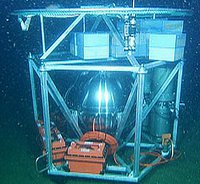Application of the Environmental Sample Processor (ESP) in Deep-Sea and Coastal Ocean Biomes

When: June 29, 2009 11AM PDT


In late April 2009, a team of MBARI researchers tested the world’s only deep-sea robotic DNA lab beneath the waters of Monterey Bay. This instrument is the latest version of the Environmental Sample Processor (ESP), which MBARI molecular biologist Chris Scholin has been developing for over 10 years. The ESP is a self-contained robotic laboratory that collects samples of seawater and tests these samples for different types of genetic material, such as DNA.
Over the last several years, Scholin and his team have used the ESP to study microscopic marine life near the sea surface in Monterey Bay. However, adapting the ESP to work in deep water added new challenges to what was already a very complicated project. Because of the immense pressure in the deep sea, the researchers had to build a special pressure housing to protect the delicate instrument. They also had to design and build an automated system to “depressurize” seawater before it could be introduced into the ESP.
Later this spring, the deep-ESP team will test the instrument for several days in water about 2,900 meters deep, offshore of Monterey Bay. In August, 2009, the deep ESP will be deployed for its first scientific mission – to study microorganisms near hydrothermal vents off the coast of Oregon. Later in 2009 it will be hooked up to the MARS undersea observatory, which will allow the team to run experiments and gather data from shore.
 A Talk With Jim Green
A Talk With Jim Green What Can Extant Genomes Reveal About Early DNA Metabolism?
What Can Extant Genomes Reveal About Early DNA Metabolism? What We Talk About When We Talk About Earth's Oxygenation
What We Talk About When We Talk About Earth's Oxygenation Bowling With Astrobiologists: A Twisted Path Toward the Origin of DNA
Bowling With Astrobiologists: A Twisted Path Toward the Origin of DNA